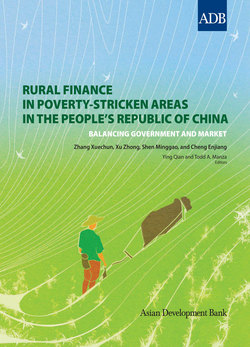Читать книгу Rural Finance in Poverty-Stricken Areas in the People's Republic of China - Xuechun Zhang - Страница 10
На сайте Литреса книга снята с продажи.
Opening to Informal Finance
ОглавлениеInformal finance covers lending between individuals and enterprises, lending through moneylenders (brokers), rotating savings and credit associations, pawns, chambers of commerce, underground banks, trade financing, and so forth. In some places, Buddhist temples serve as a platform for financing activity. In the PRC, these financing modes used to be called underground finance or illegal finance; they are now known as informal finance.
The key to opening financial markets to domestic players is to endow enterprises and individuals with lawful financial rights, enabling those most effective in capital utilization to lawfully participate in financing activities
Finance is an extension of trade in goods, and credit from transaction is the foundation of finance. The famous Shanxi Draft Bank was developed based on industrial capital, and other communities have managed to combine industrial capital with financial capital. However, there were no banks or specialized banking regulatory authorities in the PRC during the late 19th and early 20th centuries. In Hong Kong, China, there still is no central bank, although a few financial institutions print Hong Kong dollars. So-called formal financial institutions grow out of successful informal financial institutions, the only difference being whether an institution is accepted by regulatory authorities. The development of formal finance will not and should not restrict the existence and development of informal finance, and the financial rights of individuals and enterprises should be protected, not constrained.
In developed market economies where the criteria for market entry are much lower, there are few informal financial institutions. Formal financial institutions employ some informal finance principles, such as the “church steeple” principle that the borrower is much more important than collateral or the courts. A good financial institution should be able to see its clients and know what they are doing, as from the steeple of a church.
A good financial institution should be able to see its clients and know what they are doing, as from the steeple of a church
The discrimination against informal finance in the PRC stems from the protection of state-owned financial institutions, but such protection actually dumps the baby with the bathwater. At present, existing informal finance is based on individual credit, addresses information asymmetry, guaranties loans through social capital, complements formal finance, and can become an important mechanism for interest rate discovery.
First, informal finance is based on individual credit. An individual’s credit record is established through culture; folk custom; geographic, kinship, personal, or business relationships; and other social networks that keep detailed “records” about reputations, business activities, and social relationships. Moneylenders, rotating savings and lending associations, and the like are financial organizations based on credit platforms.
Second, informal finance addresses information asymmetry by using layered information and various low-cost informal information sources. Community-based organizations such as chambers of commerce and guilds, production organizations such as specialized technology associations for farmers or cooperative production associations, intermediaries such as reputed celebrities in local areas, and other organizations with abundant access to information, such as automobile clubs, pigeon-raising clubs, and temples, are used to distinguish borrowers, screen lending projects, and reduce credit risks. For example, some relatively large enterprises can gauge farmers’ credit demand and evaluate credit risks through their long-term supply and marketing relationship with farmers. More importantly, lenders can reduce repayment risks by linking loan repayment with proceeds. The lending shops emerging in some areas are established on a natural relationship with production cooperatives. Such practices also can allow the informal financial market to play an important part in interest rate discovery.
Third, informal finance can guarantee loan security by using social capital—forms of informal agreement based on social networks, informal organizations, and social customs—to replace collateral or courts. Social capital represents a kind of virtual collateral or court, and functions similarly. The difference is that most social capital is established by usage, thus offering a much less expensive way to settle lending disputes.
In the early stage of economic development, informal finance can dissolve risks before, during, and after loan issuance, making it a cheaper institutional arrangement than formal finance. For example, before a loan is issued, informal finance can use various information sources to screen borrowers and lending projects, thus preventing reverse selection of riskier borrowers, who are more willing to apply for loans even when the interest rate is high. Such screening can help reduce risk before a loan is made. Moreover, when a loan is provided, the lender can prevent moral hazard on the part of the borrower, because the purpose of the loan is clear. Finally, after a loan is provided, a lender can prevent a borrower’s strategic default by using peer pressure, group punishment in which all informal financial organizations respond together to stop lending to the defaulter, or a boycott of the defaulter’s business.
Fourth, the relationship between informal and formal finance is both competitive and supplementary. Studies have shown that competition from informal finance exerts a positive effect on the governance structure and the performance of formal financial institutions. On the one hand, competition promotes innovation by formal financial institutions; on the other hand, formal financial institutions can learn from informal finance. International experience also indicates that formal finance can utilize the information advantage of informal finance when lending to start-ups, which can become clients of formal financial institutions after establishing a credit record. In some localities, formal and informal financial institutions even diversify credit risk by issuing joint loans.
